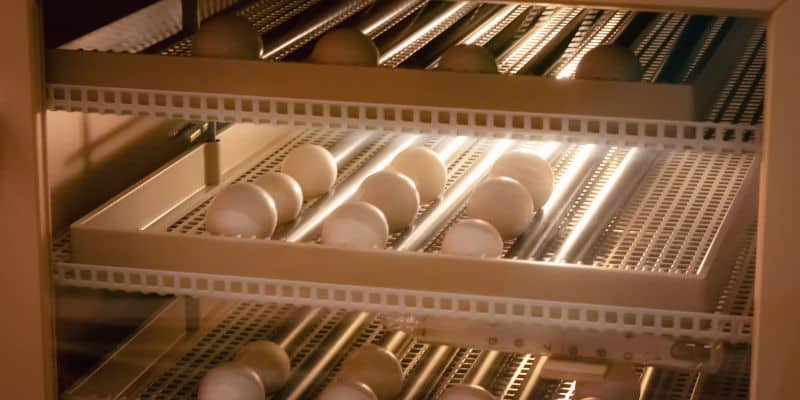Watching hatchling tortoises crawl out of their eggs for the first time is one of the most rewarding experiences keepers can enjoy. Successfully breeding your tortoises is not only a wonderful achievement, but it also means you’ve been taking exceptionally good care of your pets – stressed or unhealthy animals rarely produce young.
But in order to achieve this kind of captive-breeding success, you’ll need to understand how to incubate the tortoise eggs. The incubation process can be tricky, as there’s a lot you’ll need to learn and equipment you’ll need to acquire if you hope to bring new tortoises into the world. Read on to find out more!
Natural vs Artificial Incubation
The first thing you’ll need to decide when attempting to incubate tortoise eggs is whether you want to use natural or artificial incubation.
To incubate tortoise eggs naturally, you’ll simply leave them buried and allow the sun to provide the necessary heat. By contrast, artificial incubation entails digging up the eggs once they’re deposited and moving them to a special temperature- and humidity-controlled environment called an incubator.
Natural Tortoise Egg Incubation

Natural incubation isn’t very popular among modern tortoise breeders, as there are a lot of potential problems that can occur. But it’s certainly possible – tortoises have been incubating their eggs this way for millions of years.
The biggest challenge natural incubation presents is that you can’t control the incubation environment’s temperature or humidity level. If your area suffers unusually warm, cool, dry, or wet weather, the eggs may not hatch at all. Egg-stealing predators are also a concern, as animals ranging from snakes to foxes to raccoons may dig up your eggs and eat them.
Additionally, you’ll have to watch for the young to begin hatching so that you can move them to appropriate enclosures. Because some tortoise eggs have remarkably variable incubation durations, this means you may have to monitor the deposition site for quite some time.
However, natural incubation is much easier than artificial incubation – you don’t have to do anything except wait for the young tortoises to hatch and dig their way to the surface.
Artificial Tortoise Egg Incubation

If you intend to incubate your tortoise eggs artificially, you’ll need to dig up the eggs, move them to an incubator, and maintain suitable conditions until they’re ready to hatch.
This certainly represents more work than natural incubation, but because you can protect the eggs from predators and control the environmental parameters, it typically leads to better hatch rates. Accordingly, most modern tortoise breeders opt for this approach.
Additionally, artificial incubation sometimes allows keepers to decide which sex the resulting offspring will become. This provides an obvious and important benefit for professional tortoise breeders, as they can produce a larger number of females (who’ll then go on to lay more eggs) than by leaving things to chance.
Tortoise Egg Incubation Equipment
To incubate your tortoise eggs artificially, you’ll need to acquire some equipment and supplies. We’ll lay out the most important items you’ll need below.
Incubator
An incubator is a specialized box that is designed to maintain specific temperatures and humidity levels. First-time breeders are best served by purchasing a commercial egg incubator, though experienced breeders sometimes construct custom-built incubators.
Incubators vary widely in terms of design and materials, but most essentially consist of an insulated box, a heating element, and a thermostat. Some also feature viewing windows that allow you to monitor your eggs without having to open the door (which can lead to drastic temperature swings).
Egg Boxes
You usually don’t want to place your eggs directly in the incubator; instead, you want to place them in small boxes, which are then placed inside the incubator. This provides a number of benefits, such as providing another level of insulation that helps keep the egg temperature stable, as well as making it easier to organize large numbers of eggs.
Small plastic storage boxes generally make good egg boxes, just be sure to select ones that fit well in the incubator. A few small holes are typically drilled into the egg boxes to allow for some air exchange.
Are You Starving Your Tortoise?
Save 10% on premium tortoise food and supplements from Tortoise Resource Center on Amazon now using code BUYNOWGET10

Sulcata Vitamin & Mineral Topper Supplement
30-Day Supply | 2 oz (56 g)
$24.99

Baby Sulcata Tortoise Superfood Powder
30-Day Supply | 2.5 oz (70.8 g) Bag
$24.99
Incubation Media
You’ll want to partially fill the egg boxes with some type of slightly damp incubation media. This helps prevent the eggs from moving around, and it serves as a moisture reservoir that’ll keep the humidity inside the egg box high.
There are a variety of incubation media you can use, though vermiculite is far and away the most common choice. To prepare the vermiculite for use in the egg-deposition boxes, add a small amount of water to it, until it will clump when grasped in the hand. But then, you’ll want to squeeze out any excess water. The media should be slightly damp, but not wet.
Thermometer
You’ll usually need to purchase and use a digital, indoor-outdoor thermometer with the incubator. You can leave the display portion of the unit outside the incubator for easy viewing, while placing the remote probe inside. Some thermometers even provide min-max functions, which allow you to track temperature fluctuations over time.
High-end incubators typically come equipped with a thermometer, but it’s always a good idea to install an additional one as a backup.
Small Flashlight
A small flashlight can make it possible to see the developing egg during the course of incubation – a technique called “candling.” To do so, turn all of the lights in the room off and gently hold the flashlight up to the eggshell. This will partially illuminate the interior.
Eggs that appear uniformly yellow are either infertile or haven’t begun developing yet (they may be at a state called diapause – more on this later). Fertile, developing eggs generally have a pink or red hue, and you’ll likely be able to see the embryo as a red spot. You should also be able to see blood vessels on the inside of the shell.
Over time, the eggs will calcify, which will prevent you from seeing inside very well.
Note that you don’t need a super strong flashlight to candle eggs. In fact, excessively strong lights will produce a significant amount of heat, which may damage the developing embryo.
Digging Up Your Tortoise Eggs
Most tortoises begin exhibiting signs that egg deposition is imminent, such as being restless, sniffing the ground frequently, or digging holes. Once you notice these signs, you’ll want to begin monitoring your tortoise carefully. As soon as she deposits the eggs, you’ll want to collect them.

To do so, you’ll need to grab an ordinary pencil, one or more egg boxes (half-filled with vermiculite), and a small hand shovel if the eggs are buried deeply. Gently remove the soil until you expose the egg mass.
Before you do anything else, make a small mark on the top of each egg (the part facing directly up). This will help to ensure you avoid rotating the eggs, which can kill the developing embryos. Some breeders also like to number the eggs for record-keeping purposes.
Once you’ve marked the eggs, you can begin transferring them to the egg boxes. Try to bury them halfway in the vermiculite.
At times, the eggs may be adhered to each other. In such cases, try to move the entire mass from the ground to the egg box, disturbing it as little as possible. Do not bury such adhered egg masses in vermiculite – simply place them on top, using care to ensure that the mass is stable.
At this point, you can move the egg boxes to the incubator.
Tortoise Egg Incubation Temperatures
We’ll share the basics of tortoise egg incubation below, but it’s important to understand that the precise conditions that’ll result in good hatch rates vary from one species to the next.
Also, regardless of the species you’re keeping, be sure to have your incubator running for at least one week before the eggs arrive so that you can achieve proper temperatures and make any adjustments necessary.
General Incubation Temperatures and Times
Most tortoise eggs can be incubated at approximately 80 to 90 degrees Fahrenheit. However, each species tends to produce the best hatch rates at slightly different temperatures.
However, the length of the incubation period varies quite a bit, based on the specific temperature provided. Generally speaking, the higher the incubation temperature, the shorter the incubation period. Conversely, low incubation temperatures result in longer incubation times.
Incubation duration also varies from one species to the next. Some species, including Marginated tortoises (Testudo marginata) have relatively short incubation periods, ranging from 60 to 100 days. Meanwhile, Leopard tortoise (Stigmochelys pardalis) eggs occasionally require incubation periods of more than 400 days.
Do note that the eggs in a given clutch don’t necessarily develop at the same rate. This means that they may not all hatch at the same time.
Temperature-Dependent Sex Determination
Interestingly, the sex of most tortoises isn’t determined genetically, as it is in humans and many other animals. Instead, it is the temperature at which the eggs are incubated that determines an individual’s sex. Called temperature-dependent sex determination, this phenomenon also occurs in crocodilians and some geckos.
This means that you can usually determine the sex of your hatchlings by manipulating the incubation temperature.
It still isn’t clear what the temperature thresholds are for many tortoise species, though it is thought that warmer incubation temperatures produce females, while cooler incubation temperatures produce males. Incubation temperatures between the extremes produce a mix of both sexes.
Diapause
Many tortoise eggs experience a pause in their developmental process, called diapause. During this time, the tortoise does not develop – think of it as a holding pattern. Some tortoises exhibit a diapause at the beginning of their incubation period, while others exhibit the opposite trend.
Many species that exhibit diapause require a “trigger” to initiate development. This usually takes the form of different temperatures or humidity levels.
For example, Burmese star tortoises (Geochelone platynotan) require a cool period relatively early during the incubation process before they’ll start developing. Meanwhile, some tropical South American species – such as red-footed tortoises (Chelonoidis carbonarius) – require an increase in humidity at the end of the incubation period to trigger final development and hatching. Other species, such as star tortoises (Pyxis arachnoides), require a diapause during the middle of the incubation period.
Humidity During Egg Incubation
While temperature levels are fairly easy to set, monitor, and adjust, the humidity level inside the egg boxes may require a bit of experimentation.
Accordingly, you’ll need to monitor your eggs closely while they develop. If you see the eggs begin to dimple or dent, they may be dehydrating, so you’ll want to add a small amount of water to the egg incubation media. Just be careful to avoid allowing the eggs themselves to become wet.
On the other hand, if you note fluid seeping from the eggs, the humidity level may be too high. In such cases, you’ll want to mix a little dry vermiculite in with the existing media to help reduce the moisture.
In all cases, try to make humidity adjustments gradually.
Citations
- Star Tortoise Garden – Star Tortoise Incubation
- Arizona State University — Temperature-Dependent Sex Determination in Reptiles
- California Turtle & Tortoise Club — General Guide to Incubating Turtle and Tortoise Eggs
- Reptiles Magazine – Spider Tortoise Care and Breeding


